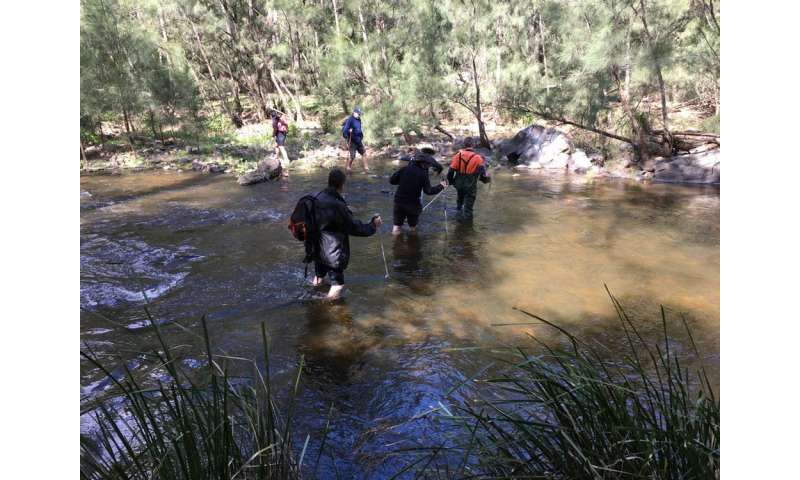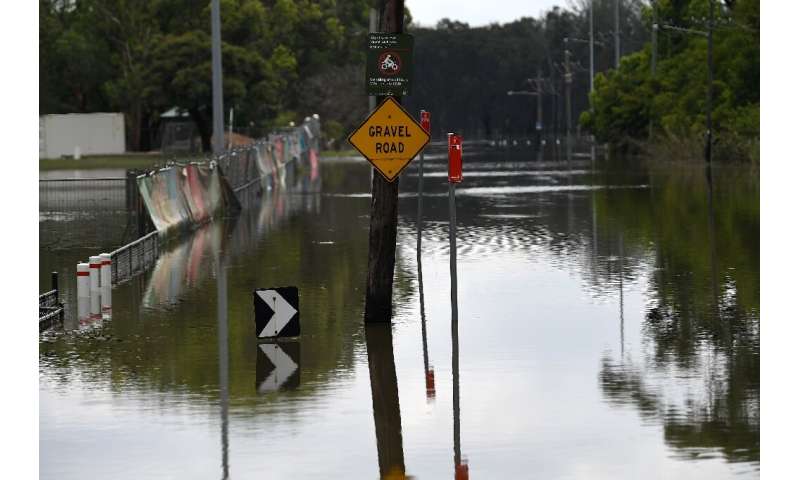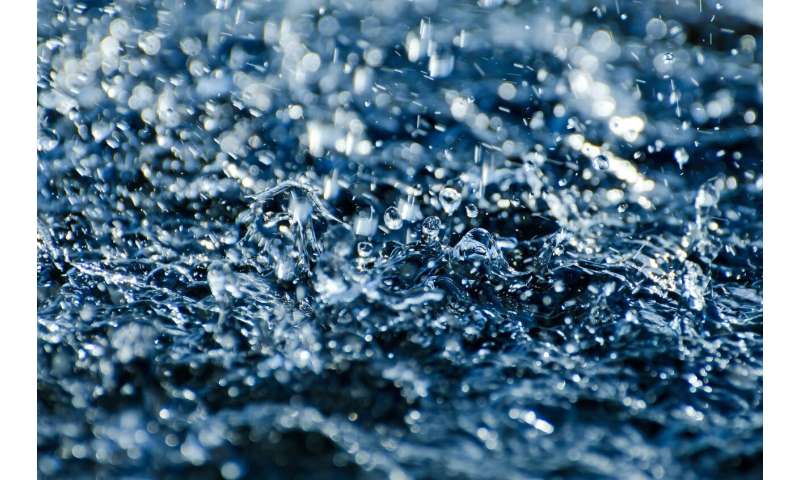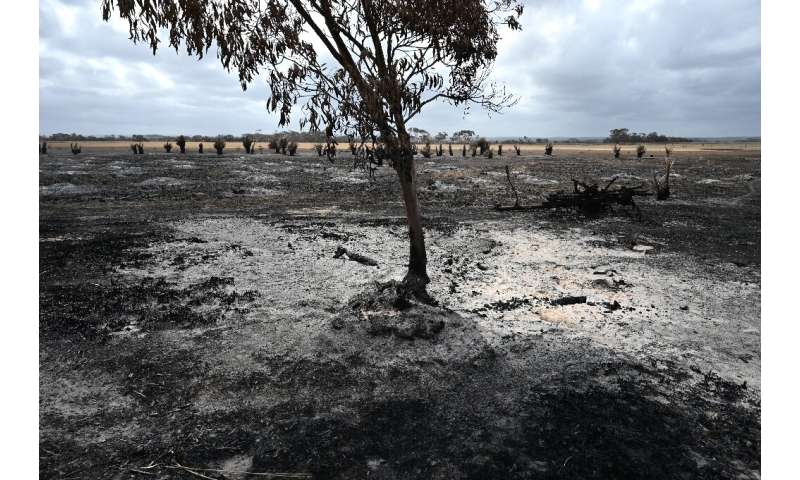FEBRUARY 13, 2020
Heavy rains are great news for Sydney's dams, but they come with a big caveat

Throughout summer, Sydney's water storage level fell alarmingly. Level 2 water restrictions were imposed and the New South Wales government prepared to double the capacity of its desalination plant.
But then it began to rain, and rain. Sydney water storages jumped from 41% in early February to 75% now – the highest of any capital city in Australia.
This is great news for the city, but it comes with a big caveat. Floodwaters will undoubtedly wash bushfire debris into reservoirs—possibly overwhelming water treatment systems. We must prepare now for that worst-case pollution scenario.
Reservoirs filled with rain
The water level of Sydney's massive Lake Burragorang—the reservoir behind Warragamba Dam—rose by more than 11 meters this week. Warragamba supplies more than 80% of Sydney's water.
Other Sydney water storages, including Nepean and Tallowa dams, are now at 100%.WaterNSW report that 865,078 megaliters of extra water has been captured this week across all Greater Sydney's dams.
This dwarfs the volume of water produced by Sydney's desalination plant, which produces 250 megaliters a day when operating at full capacity. Even at this rate, it would take more than 3,400 days (or nine years) to match the volume of water to added to Sydney's supply this week.
But then comes the pollution
Thankfully, the rain appears to have extinguished bushfires burning in the Warragamba catchment for months.
But the water will also pick up bushfire debris and wash it into dams.
Over the summer, bushfires burnt about 30% of Warragamba Dam's massive 905,000 hectare water catchment, reducing protective ground cover vegetation. This increases the risk of soil erosion. Rain will wash ash and sediment loads into waterways—adding more nitrogen, phosphorous and organic carbon into water storages.
Waterways and ecosystems require nutrients like phosphorous and nitrogen, but excess nutrients aren't a good thing. They bring contamination risks, such as the rapid growth of toxic blue-green algae.
Drinking water catchments will always have some degree of contamination and water treatment consistently provides high quality drinking water. But poor water quality after catchment floods is not without precedent.
We've seen this before
In August 1998, extreme wet weather and flooding rivers filled the drought-affected Warragamba Dam in just a few days.
This triggered the Cryptosporidium crisis, when the protozoan parasite and the pathogen Giardia were detected in Sydney's water supplies. It triggered health warnings, and Sydneysiders were instructed to boil water before drinking it. This event did not involve a bushfire.
The Canberra bushfires in January 2003 triggered multiple water quality problems. Most of the region's Cotter River catchments, which hold three dams, were burned. Intense thunderstorms in the months after the bushfire washed enormous loads of ash, soil and debris into catchment rivers and water reservoirs.
This led to turbidity (murkiness), as well as iron, manganese, nitrogen, phosphorus and carbon in reservoir waters. The inflow of organic material also depleted dissolved oxygen which triggered the release of metals from reservoir sediment. At times, water quality was so poor it couldn't be treated and supplied to consumers.
The ACT Government was forced to impose water restrictions, and built a A$38 million water treatment plant.
Have we come far enough?
Technology in water treatment plants has developed over the past 20 years, and water supply systems operates according to Australian drinking water guidelines.
Unlike the 1998 Sydney water crisis, WaterNSW, Sydney Water and NSW Health now have advanced tests and procedures to detect and manage water quality problems.
In December last year, WaterNSW said it was aware of the risk bushfires posed to water supplies, and it had a number of measures at its disposal, including using booms and curtains to isolate affected flows.
However at the time, bushfire ash had already reportedly entered the Warragamba system.
Look to recycled water
Sydney's water storages may have filled, but residents should not stop saving water. We recommend Level 2 water restrictions, which ban the use of garden hoses, be relaxed to Level 1 restrictions which ban most sprinklers and watering systems, and the hosing of hard surfaces.
While this measure is in place, longer term solutions can be explored. Expanding desalination is a popular but expensive option, however greater use of recycled wastewater is also needed.
Highly treated recycled water including urban stormwater and even treated sewage should be purified and incorporated into the water supply. Singapore is a world leader and has proven the measure can gain community acceptance.
It's too early to tell what impact the combination of bushfires and floods will have on water storages. But as extreme weather events increase in frequency and severity, all options should be on the table to shore up drinking water supplies.
Dams overflow as Australia braces for more floods
FEBRUARY 13, 2020

Dams near Sydney overflowed Thursday after days of torrential rain, as Australia braced for more storms expected to bring dangerous flash flooding to the country's east.
Recent downpours have brought relief to areas ravaged by bushfires and drought—as well as chaos and destruction to towns and cities along the eastern seaboard.
On Thursday, Nepean Dam south of Sydney was at full capacity and spilling over, with video footage showing excess water cascading over the dam wall and downstream.
Two other dams in New South Wales, Tallowa and Brogo, were also overflowing and more dams could reach capacity in the coming days, a WaterNSW spokesman told AFP.
Sydney's dams have seen water levels spike dramatically—the Nepean was just a third full less than a week ago—though many inland areas are facing severe water shortages missed out on the flows.
A devastating months-long bushfire crisis that killed 33 people has effectively been ended by the downpours, with just one blaze yet to be brought under control in New South Wales.
Hundreds of people have been rescued from floodwaters in recent days.
Police said a man's body was discovered in a flooded river on Queensland's Sunshine Coast on Thursday, though the cause of his death was not immediately clear.
Wild weather is set to ramp up again from Friday, with the Bureau of Meteorology forecasting ex-Tropical Cyclone Uesi would bring "damaging to destructive winds" and heavy rainfall to remote tourist destination Lord Howe Island.
Senior meteorologist Grace Legge said storms were also expected for Queensland and New South Wales—with areas still recovering from bushfires likely to be hit again.
"Any showers and thunderstorms that do develop are falling on already saturated catchments, so there is a risk with severe thunderstorms of flash flooding," she said.
Emergency services have warned residents in affected areas to be cautious in the dangerous conditions.
FEBRUARY 11, 2020
Floods fail to end Australia's years-long drought

Heavy rain has given hope to Australia's drought-stricken regions, but scientists warned Tuesday sustained falls were needed to end a years-long dry spell.
Stormy weather has brought days of chaos and destruction in the country's east, with one man missing after his car was swept off a road in Sydney's north and hundreds more rescued from floodwaters.
In the small town of Stanthorpe, Queensland, Tracy Dobie said the rain had been "a boost for everyone".
"But the drought has not ended," the regional mayor told AFP.
"Our land is so dehydrated—we've gone three years without rain in some places and five years in others—it's going to take a long time to get moisture back in the soil."
Hydrologists believe this week's deluge—which has caused flooding and doused many fires—is a taste of things to come, with cities getting inundated while rural areas struggle to offset worsening droughts.
Professor Ashish Sharma from the University of New South Wales said heavy rain can give people in cities a "twisted view" of the impact, as water builds up on hard surfaces.
Even as people in cities see flooding and property damage, in rural regions sustained rainfall is needed to soak through the dry soil before dams fill.
During the latest downpours—the heaviest in 30 years in some areas—dam levels near Sydney have risen dramatically.
But most of New South Wales' drought-hit towns facing down a water "Day Zero" had seen "negligible" increases, as much of the rain was flowing into rivers not dams, said a spokesman for WaterNSW, which manages the state's water resources.
"Unfortunately (that is) largely because the volume hasn't been sufficient and the catchments are extremely dry after a very hot start to the summer and a prolonged drought," he said.
Despite climate change driving increases in extreme rainfall, Sharma and his team predict it will not be enough to keep up with rising temperatures.
Moderate and frequent floods, which form "the backbone of all our water supply", will likely decrease, Sharma said.
"I just hope that people have the wisdom and the foresight to realise that this should not be seen as a sign of not needing to act," he added.
Dobie said the rain was more than welcome but "one rain event doesn't close the door on the drought".
"We need a year of average rainfall."
FEBRUARY 10, 2020
Downpours to end Australia bushfires within days
UH NO

Australia's months-long bushfires crisis will likely be over within days, officials said Monday as heavy rainfall extinguished several massive blazes and was forecast to douse dozens more as downpours swept south.
Days of torrential rains have caused flash flooding in New South Wales and Queensland, dampening once-raging fires that volunteers had battled in vain for months.
Sydney experienced its wettest period in 20 years amid several days of heavy rainfall that led to chaotic scenes across the city.
The Bureau of Meteorology said 391.6mm (15.42 inches) of rain fell in Sydney over the past four days—the highest total in such a period since 414.2mm were recorded in February 1990.
Several major bushfires have been extinguished by the deluge, including a "mega-blaze" that burned through 500,000 hectares (1.2 million acres) north of Sydney and a similar-sized fire to the city's south, bringing relief to residents and firefighters.
New South Wales Rural Fire Service spokesman James Morris said about 30 fires were still burning Monday, but it was expected they would soon be extinguished as the rain moves south in the coming days.
"By the end of the week it's likely they will be out," he told AFP.
Drought-stricken areas across the country's east also received welcome downpours but more sustained and widespread rainfall will be needed to offset a years-long dry spell.
The stormy weather has brought days of chaos and destruction, with one man missing after his car was swept off a road in Sydney's north and hundreds more rescued from floodwaters across the state.
Police said a search was under way for the missing man Monday but no sign of him or his vehicle had been found.
Several rivers, including the Parramatta River in Sydney's west, overflowed while residents living near Narrabeen Lagoon in the city's north were ordered to evacuate late Sunday amid fears their homes could be inundated.
Emergency services scrambled to respond to calls for assistance as strong winds uprooted trees, ocean foam coated seaside homes and boulders fell on parked cars.
Almost 90,000 homes remained without power Monday, with utility providers warning it could take days for electricity to be restored in some areas.
The Insurance Council of Australia said insurers had received an estimated Aus$45 million ($30 million) in claims by early Monday, with that figure expected to rise as the full extent of the damage becomes clear
No comments:
Post a Comment